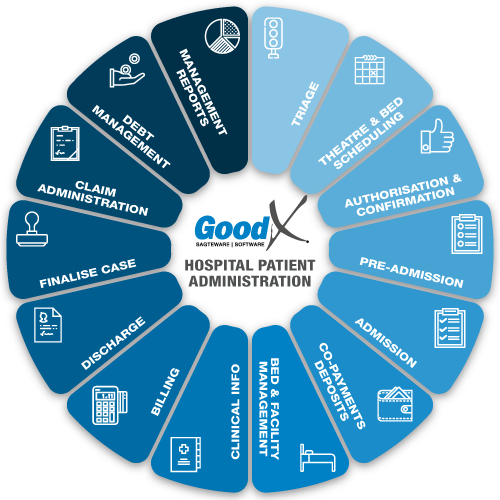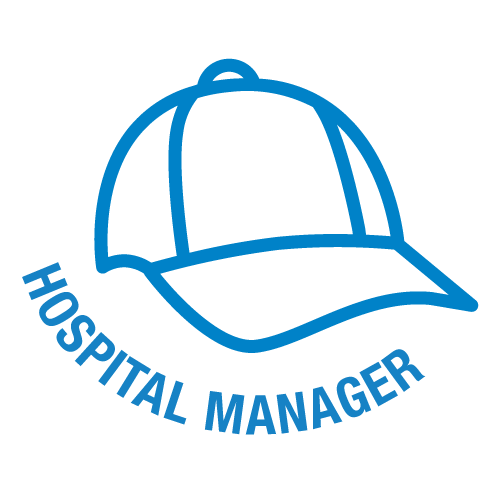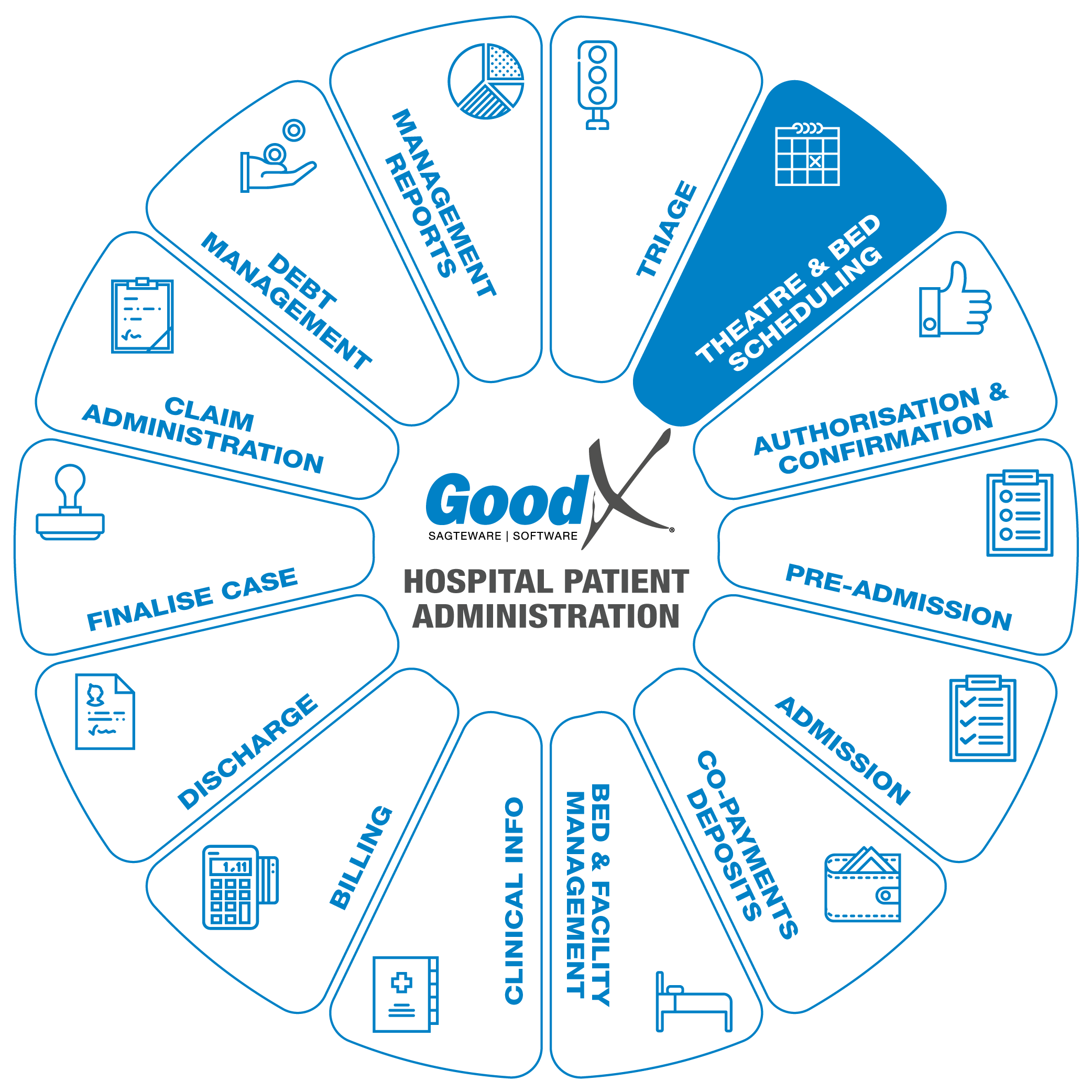Best Practice Guidelines: Hospital Patient Administration

Copyright © 2019 GoodX Software. All rights reserved.
GoodX online Learning Centre
learning.goodx.co.za
4. Theatre and Bed Scheduling
Responsible Roles
 |
Check if there are enough beds for all the patients that are scheduled. Ensure reception and theatre know the procedures to schedule a patient for theatre or for a bed. When there is not enough bed for the patients have a procedure to show the patient to other hospitals. Ensure all admin are up to date to make the correct calls in any situation.i9 |
|---|---|
 |
Receive all the theatre bookings from the practitioners that must be scheduled for theatre and all the information that will be needed. Ensure the authorization have been done or are in progress. Supply the theatre nurses with the theatre list for the following day that the stock can be ordered from the main store and packed out correctly according to the procedures that will take place for the following day. Check where the patients will be before the operation and need to be collected from. Ensure the correct CPT4 codes were received according to the procedures that must be done on the patients. Allocate the patient to the correct theatre in cases where certain theatres are used for certain procedures. |
|
|
Ensure the patient has signed all the necessary consent forms and all the information were sent to the hospital for the correct booking for the theatre and the bed the patient will need with admission. Use the time given by the hospital for theatre bookings are used productive and scheduled as soon as possible. |
|
|
Allocated the patient to the correct ward and bed, to ensure when the patient arrives at the hospital with admission, the patient room and bed are available and clean. Inform the Hospital manager when all beds are full and the hospital can not admit any more patients. Get all the correct and necessary information to book the bed. |
 Purpose of Theatre and Bed Scheduling
Purpose of Theatre and Bed Scheduling
Theatre scheduling will be done by the theatre nurse. The information will be received from the practice where the patient was seen and decided there will be an operation needed on the patient. The theatre must be scheduled to ensure the correct theatre are booked and that the hospital has open space for that day in the theatre, correct staff members and the correct stock items for that operation or procedure that must be done in the theatre.
Bed scheduling will be done by the reception of the hospital. The patient will be allocated to a bed to ensure enough beds in the hospital for all the patients that will be treated at the hospital. The patient can have an illness that needs to be treated in the hospital and will then be allocated to a bed for admission.
The patient can be booked for a theatre and a bed, or the patient can only be booked to a bed and not theatre.
Critical Steps of Theatre and Bed Scheduling
Note: References to a hospital in this book includes acutes, sub-acutes, day hospitals, rehab centres etc.
Bookings will be used to assist in managing the hospital in the planning process. Using a booking system to assist the hospital will provide the following management information and ability:
- How many patients the hospital can manage
- How many personnel the hospital must employ
- How active and productive the hospital and theatres are
- Time management
- Stock management
- Financial management
- Bed management
- Theatre management
The hospital can make day to day bookings, emergency bookings, theatre bookings, and personnel activity bookings on an electronic diary which is visible to all hospital staff.
Other activities like public holidays and school holidays can also be managed on the electronic diary to assist in future planning.
A diary can be pre-setup with different time intervals according to the hospital's needs. Diaries can be set up according to medical practitioners or per service centre or per theatre.
The Waiting room can be used to see if all the patients have arrived at the hospital, even though they have not yet been placed in a bed or room or a patient that is waiting for a medical practitioner.
The Waiting List can be used when the hospital is fully booked and does not have any available beds or theatre slots. The patient can be placed on a Waiting list and when there is a cancellation or open booking, the patient can be allocated to the booking.
Day to day and emergency bookings
Depending on the hospital's speciality, scheduled appointments can be booked to guide the hospital to prevent overbooking. Reports that are available on the booking types can assist in future planning during peak times in the hospital, and assist in appointing more staff members in certain busy periods of the year and to keep more stock in during these periods.
The hospital can see how many patients must arrive per day and how many beds are available, how many patients they can still admit to the hospital or have to transfer to other hospitals.
Theatre Bookings
Theatre bookings are a must in any hospital with one or multiple theatres. Theatres are a big financial asset for any hospital. They must, therefore, be managed daily per minute to make sure the best possible financial outcome is attained.
Medical practitioners must email/fax their theatre lists at least one or two days prior to the intended procedure date to the hospital. The theatre list must contain the Debtor and Patient's demographic data, the patient’s allergies, the CPT4 and ICD10 codes, and the Medical practitioner details
Theatre bookings ensure:
- That the facility has beds and theatre time available
- That all required stock for the procedures is ordered in time
- The correct staff members are on the correct shifts for the correct procedures
- That patient files are opened in advance and so that the waiting time for admission is reduced.
Critical steps of theatre bookings
1. Receive Theatre List from the Specialist
A hospital normally has fixed theatre lists for specific doctors: e.g. Monday mornings – Dr. A, Tuesday afternoons – Dr. B, or Orthopaedic lists on a Wednesday, General Surgeon Lists on a Monday afternoon, or according to procedures that must be done for example knee replacements on Fridays, Wisdom teeth on Thursdays.
Phone the doctor’s consulting rooms to get a preliminary theatre list.
The process will be more effective when the hospital has good relationships with the reception staff at the medical practices.
2. Prepare Theatre list
Theatre lists are normally prepared on a spreadsheet or pre-printed theatre bookings form or an electronic system.
Phone the patients on the theatre list and ask them to complete a pre-admission form or use the MyGrandCengral patient portal so that patients can share their demographic data electronically with the hospital.
Confirm the authorization with the medical aid if the patient is a medical aid patient.
Confirm the deposit or co-payment what the patient must bring along with admission.
Confirm if the patient did receive a list of personal items they must bring along, for example, chronic medication, and toiletries.
3. Send Theatre List to Theatre Manager
Once the theatre list for a specific day is completed, email/hand-deliver it to the theatre manager.
Any additions to the theatre list must be updated at all times.
The theatre manager must make sure the correct procedures are booked and the theatres are prepared with the correct stock items and staff members for the specific day theatre bookings.
If something is going to influence the medical practitioners they must be informed immediately.
The staff members must be up to date on the patient's allergies.
Bed Scheduling
A bed will be scheduled for patient that needs to be admitted in the hospital for an illness or procedure that must be done in a hospital. The patient that is scheduled for theatre also needs a bed to recover after the theatre. This will assist in allocating enough personnel to the correct wards.
Personnel activities
The electronic diary can be used to manage personnel time, to manage when to appoint locums to assist in the hospital and to know when one of the medical practitioners are on holiday or at a conference and are not available.

